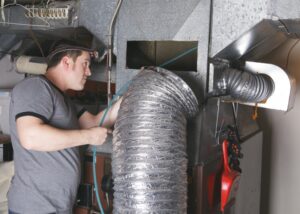 Are you utilizing a gas-powered heating system in your home? Well, then there is at least one safety risk that you really need to know about. Now, this isn’t to say that gas furnaces are automatically dangerous by nature… they aren’t. However, there is a component within your gas-powered system that could be harmful if ignored for too long–and this is the heat exchanger.
Are you utilizing a gas-powered heating system in your home? Well, then there is at least one safety risk that you really need to know about. Now, this isn’t to say that gas furnaces are automatically dangerous by nature… they aren’t. However, there is a component within your gas-powered system that could be harmful if ignored for too long–and this is the heat exchanger.
Like any other big or powerful piece of equipment or appliance that produces combustion gas, your furnace could potentially create hazards if it is not routinely maintained or repaired as soon as troubling symptoms appear.
Now, if you have a newer furnace you likely won’t deal with a cracked heat exchanger. This is a problem that usually afflicts aging furnaces. And when we say aging, we’re talking about 10-15 years old. This is the average lifespan for a well-maintained furnace system. Read on to learn more!
Your Furnace’s Heat Exchanger
The heat exchanger in your furnace is an essential component of the natural gas furnace. It’s the area where the heat from the combustion gas transfers to the air from the blower fan, which moves into the ventilation system. This combustion gas cannot come into direct contact with the air being blown into your home. Otherwise, you’d be exposed to unhealthy fumes from carbon monoxide and the like.
Instead, these gases enter the heat exchanger, which is a clam-shaped metal chamber. The heat from the combustion gases raises the temperature of the metal walls, and as the air from the blower passes around it, heat transfers to it. Essentially, the heat exchanger is what makes it possible for a furnace to actually heat the home.
Why A Cracked Heat Exchanger Is Bad
As we alluded to above, a cracked heat exchanger will allow exhaust fumes to escape from inside the heat exchanger and get into the air blowing into your home. The most toxic among these fumes is CO–carbon monoxide. This can cause severe health problems, and in some cases even fatality. When your furnace is in good condition (including the heat exchangers!) the combustion gases are expelled out of a flue. But a crack in the heat exchanger allows gas to seep out.
The reason this is typically more common with aging furnaces versus new ones is that it is often corrosion that allows a heat exchanger to crack. There is a reaction between the metal of the heat exchanger and the combustion gases over time, and the metal weakens.
Cracks in the heat exchanger will be practically invisible to the naked eye, because they shrink as they cool. But the heat exchanger expands as it heats up, which reveals the crack and then allows combustion gases to leak out. If you hear clicking as your furnace cycles off and you’ve never heard this before, it could be a cracked heat exchanger shrinking back down as it cools off.
Don’t take any chances–give our team a call!
DB Heating & Cooling, Inc serves the heating and cooling needs of customers throughout Rockland County, NY as well as Bergen County, NJ and surrounding communities. You can count on us for expert services. Contact us today for expert heater service in Emerson, NJ and beyond.
